Understanding Capital Gains Tax and its Application in Different Assets
VerifiedAdded on 2023/06/07
|11
|2719
|419
AI Summary
This article explains the concept of Capital Gains Tax and its application in different assets like jewellery, second-hand cars, shares, and homes. It also covers the exemptions and rules for claiming main residence exemption. The article provides relevant sections of ITAA 1997 and explains the cost base and cost of ownership for different assets.
Contribute Materials
Your contribution can guide someone’s learning journey. Share your
documents today.
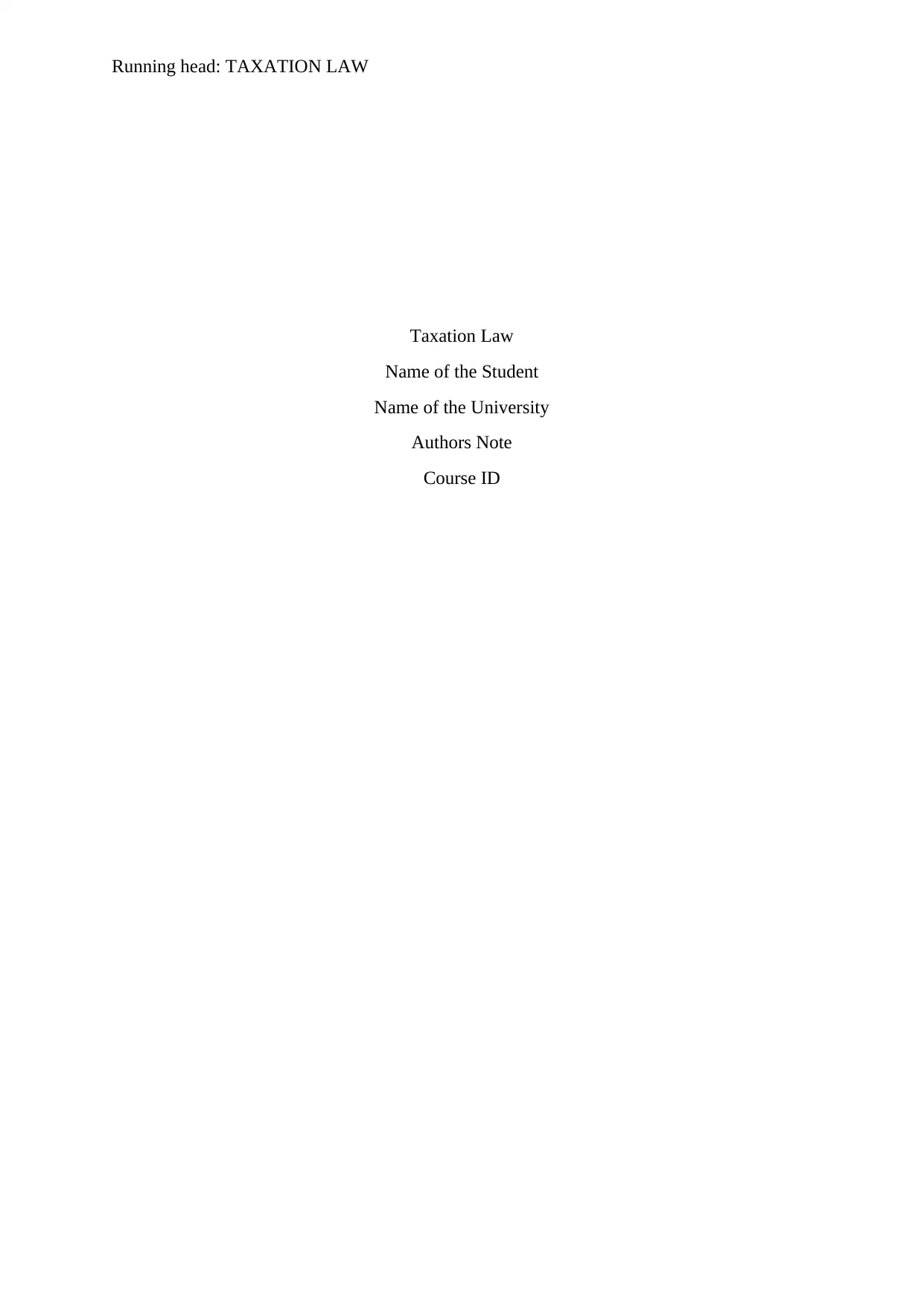
Running head: TAXATION LAW
Taxation Law
Name of the Student
Name of the University
Authors Note
Course ID
Taxation Law
Name of the Student
Name of the University
Authors Note
Course ID
Secure Best Marks with AI Grader
Need help grading? Try our AI Grader for instant feedback on your assignments.

1TAXATION LAW
Table of Contents
Brief Overview:..........................................................................................................................2
A jewellery Costs $5,000:..........................................................................................................3
A second hand car purchased for $3000:...................................................................................4
Shares in BHP:...........................................................................................................................5
Your Home:................................................................................................................................6
References:.................................................................................................................................9
Table of Contents
Brief Overview:..........................................................................................................................2
A jewellery Costs $5,000:..........................................................................................................3
A second hand car purchased for $3000:...................................................................................4
Shares in BHP:...........................................................................................................................5
Your Home:................................................................................................................................6
References:.................................................................................................................................9
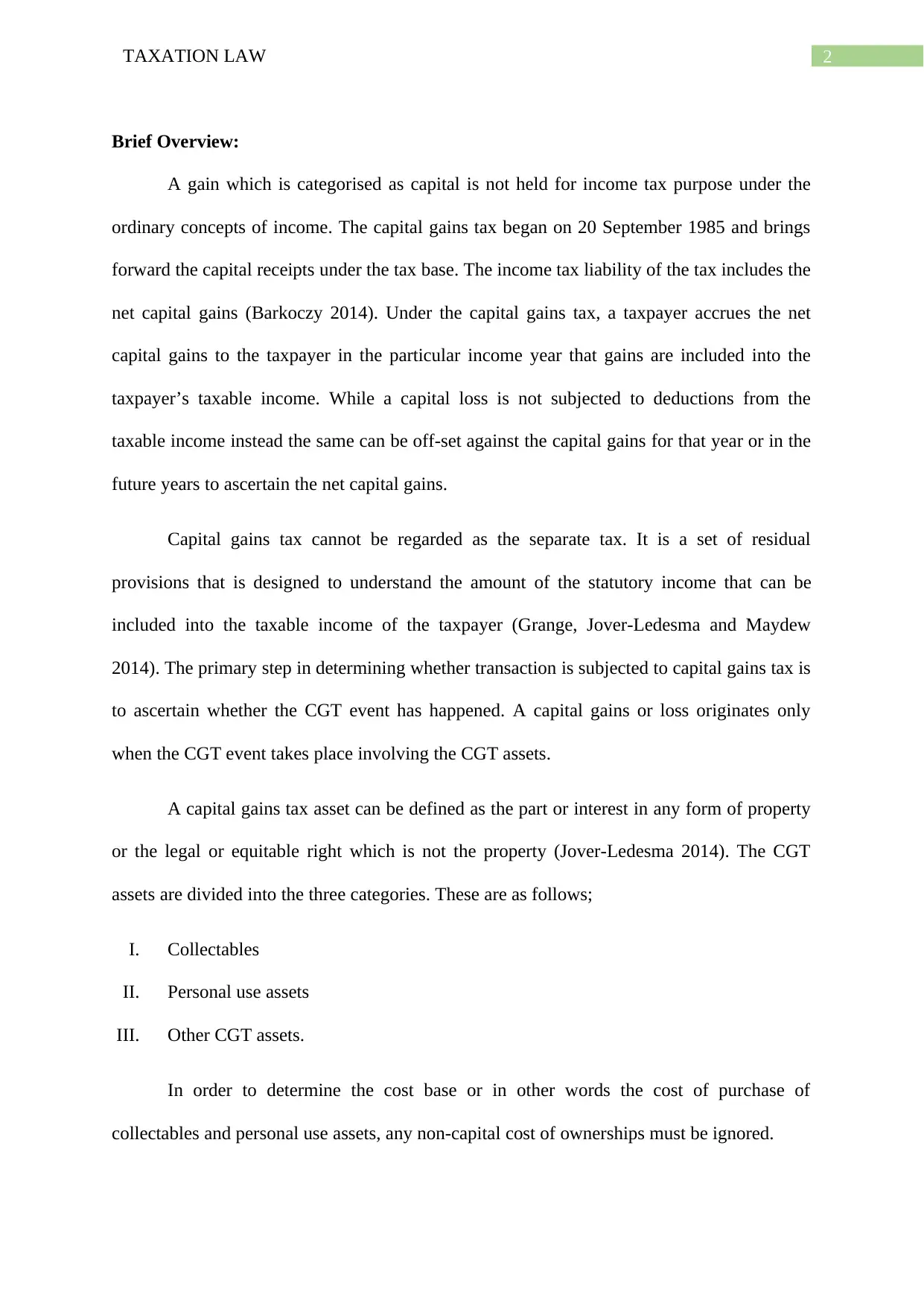
2TAXATION LAW
Brief Overview:
A gain which is categorised as capital is not held for income tax purpose under the
ordinary concepts of income. The capital gains tax began on 20 September 1985 and brings
forward the capital receipts under the tax base. The income tax liability of the tax includes the
net capital gains (Barkoczy 2014). Under the capital gains tax, a taxpayer accrues the net
capital gains to the taxpayer in the particular income year that gains are included into the
taxpayer’s taxable income. While a capital loss is not subjected to deductions from the
taxable income instead the same can be off-set against the capital gains for that year or in the
future years to ascertain the net capital gains.
Capital gains tax cannot be regarded as the separate tax. It is a set of residual
provisions that is designed to understand the amount of the statutory income that can be
included into the taxable income of the taxpayer (Grange, Jover-Ledesma and Maydew
2014). The primary step in determining whether transaction is subjected to capital gains tax is
to ascertain whether the CGT event has happened. A capital gains or loss originates only
when the CGT event takes place involving the CGT assets.
A capital gains tax asset can be defined as the part or interest in any form of property
or the legal or equitable right which is not the property (Jover-Ledesma 2014). The CGT
assets are divided into the three categories. These are as follows;
I. Collectables
II. Personal use assets
III. Other CGT assets.
In order to determine the cost base or in other words the cost of purchase of
collectables and personal use assets, any non-capital cost of ownerships must be ignored.
Brief Overview:
A gain which is categorised as capital is not held for income tax purpose under the
ordinary concepts of income. The capital gains tax began on 20 September 1985 and brings
forward the capital receipts under the tax base. The income tax liability of the tax includes the
net capital gains (Barkoczy 2014). Under the capital gains tax, a taxpayer accrues the net
capital gains to the taxpayer in the particular income year that gains are included into the
taxpayer’s taxable income. While a capital loss is not subjected to deductions from the
taxable income instead the same can be off-set against the capital gains for that year or in the
future years to ascertain the net capital gains.
Capital gains tax cannot be regarded as the separate tax. It is a set of residual
provisions that is designed to understand the amount of the statutory income that can be
included into the taxable income of the taxpayer (Grange, Jover-Ledesma and Maydew
2014). The primary step in determining whether transaction is subjected to capital gains tax is
to ascertain whether the CGT event has happened. A capital gains or loss originates only
when the CGT event takes place involving the CGT assets.
A capital gains tax asset can be defined as the part or interest in any form of property
or the legal or equitable right which is not the property (Jover-Ledesma 2014). The CGT
assets are divided into the three categories. These are as follows;
I. Collectables
II. Personal use assets
III. Other CGT assets.
In order to determine the cost base or in other words the cost of purchase of
collectables and personal use assets, any non-capital cost of ownerships must be ignored.
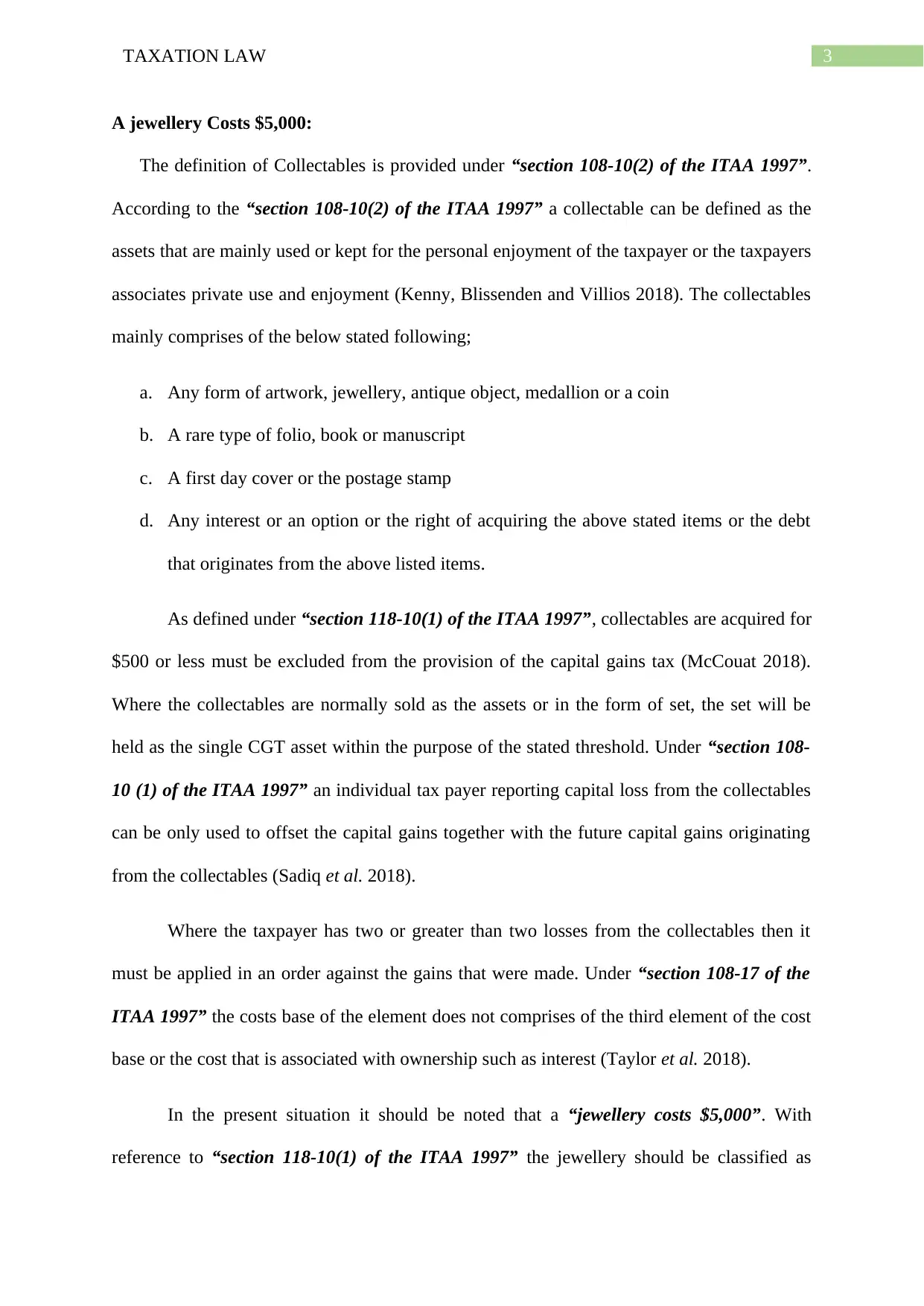
3TAXATION LAW
A jewellery Costs $5,000:
The definition of Collectables is provided under “section 108-10(2) of the ITAA 1997”.
According to the “section 108-10(2) of the ITAA 1997” a collectable can be defined as the
assets that are mainly used or kept for the personal enjoyment of the taxpayer or the taxpayers
associates private use and enjoyment (Kenny, Blissenden and Villios 2018). The collectables
mainly comprises of the below stated following;
a. Any form of artwork, jewellery, antique object, medallion or a coin
b. A rare type of folio, book or manuscript
c. A first day cover or the postage stamp
d. Any interest or an option or the right of acquiring the above stated items or the debt
that originates from the above listed items.
As defined under “section 118-10(1) of the ITAA 1997”, collectables are acquired for
$500 or less must be excluded from the provision of the capital gains tax (McCouat 2018).
Where the collectables are normally sold as the assets or in the form of set, the set will be
held as the single CGT asset within the purpose of the stated threshold. Under “section 108-
10 (1) of the ITAA 1997” an individual tax payer reporting capital loss from the collectables
can be only used to offset the capital gains together with the future capital gains originating
from the collectables (Sadiq et al. 2018).
Where the taxpayer has two or greater than two losses from the collectables then it
must be applied in an order against the gains that were made. Under “section 108-17 of the
ITAA 1997” the costs base of the element does not comprises of the third element of the cost
base or the cost that is associated with ownership such as interest (Taylor et al. 2018).
In the present situation it should be noted that a “jewellery costs $5,000”. With
reference to “section 118-10(1) of the ITAA 1997” the jewellery should be classified as
A jewellery Costs $5,000:
The definition of Collectables is provided under “section 108-10(2) of the ITAA 1997”.
According to the “section 108-10(2) of the ITAA 1997” a collectable can be defined as the
assets that are mainly used or kept for the personal enjoyment of the taxpayer or the taxpayers
associates private use and enjoyment (Kenny, Blissenden and Villios 2018). The collectables
mainly comprises of the below stated following;
a. Any form of artwork, jewellery, antique object, medallion or a coin
b. A rare type of folio, book or manuscript
c. A first day cover or the postage stamp
d. Any interest or an option or the right of acquiring the above stated items or the debt
that originates from the above listed items.
As defined under “section 118-10(1) of the ITAA 1997”, collectables are acquired for
$500 or less must be excluded from the provision of the capital gains tax (McCouat 2018).
Where the collectables are normally sold as the assets or in the form of set, the set will be
held as the single CGT asset within the purpose of the stated threshold. Under “section 108-
10 (1) of the ITAA 1997” an individual tax payer reporting capital loss from the collectables
can be only used to offset the capital gains together with the future capital gains originating
from the collectables (Sadiq et al. 2018).
Where the taxpayer has two or greater than two losses from the collectables then it
must be applied in an order against the gains that were made. Under “section 108-17 of the
ITAA 1997” the costs base of the element does not comprises of the third element of the cost
base or the cost that is associated with ownership such as interest (Taylor et al. 2018).
In the present situation it should be noted that a “jewellery costs $5,000”. With
reference to “section 118-10(1) of the ITAA 1997” the jewellery should be classified as
Secure Best Marks with AI Grader
Need help grading? Try our AI Grader for instant feedback on your assignments.

4TAXATION LAW
“collectables” (Woellner et al. 2018). This is because the cost base of the asset or in other
words the purchase cost of the assets is greater than $500. As the cost base of asset is greater
than $500, any capital gains that is made from the sale of jewellery would be included into
the assessable income of the taxpayer.
A second hand car purchased for $3000:
“Section 108-20 (2) of the ITAA 1997” provides the definition of the personal use assets.
According to the “section 108-20 (2) of the ITAA 1997” the personal use assets comprises of
the assets that is mainly used or kept by the taxpayer for their personal use or enjoyment but
does not comprises of the land or building (Robin 2017). The personal use assets represents
the non-collectable assets used by the taxpayer for their private use. The personal use assets
comprises of the boats, furniture, electrical goods and household items. Other examples of the
personal use assets includes;
a. Television at home
b. Mobile phone for personal use
c. A bicycle
d. Yacht owned by the taxpayer for their private use and enjoyment.
However, under “section 108-20(3) of the ITAA 1997” the personal use does not
takes into the account land and building given the asset is considered as collectable
(Blakelock and King 2017). Furthermore, “section 108-30 of the ITAA 1997” provides that
the cost base of the personal use asset does not comprises of the third element of the cost base
or the cost associated with the ownership namely an interest.
Under “section 118-10 (3) of the ITAA 1997” any form of capital gains should be
ignored where the personal use asset was purchase for $10,000 or less (Martin and Connor
2017). This represents that the taxpayer are only under the obligation of keeping the details
“collectables” (Woellner et al. 2018). This is because the cost base of the asset or in other
words the purchase cost of the assets is greater than $500. As the cost base of asset is greater
than $500, any capital gains that is made from the sale of jewellery would be included into
the assessable income of the taxpayer.
A second hand car purchased for $3000:
“Section 108-20 (2) of the ITAA 1997” provides the definition of the personal use assets.
According to the “section 108-20 (2) of the ITAA 1997” the personal use assets comprises of
the assets that is mainly used or kept by the taxpayer for their personal use or enjoyment but
does not comprises of the land or building (Robin 2017). The personal use assets represents
the non-collectable assets used by the taxpayer for their private use. The personal use assets
comprises of the boats, furniture, electrical goods and household items. Other examples of the
personal use assets includes;
a. Television at home
b. Mobile phone for personal use
c. A bicycle
d. Yacht owned by the taxpayer for their private use and enjoyment.
However, under “section 108-20(3) of the ITAA 1997” the personal use does not
takes into the account land and building given the asset is considered as collectable
(Blakelock and King 2017). Furthermore, “section 108-30 of the ITAA 1997” provides that
the cost base of the personal use asset does not comprises of the third element of the cost base
or the cost associated with the ownership namely an interest.
Under “section 118-10 (3) of the ITAA 1997” any form of capital gains should be
ignored where the personal use asset was purchase for $10,000 or less (Martin and Connor
2017). This represents that the taxpayer are only under the obligation of keeping the details

5TAXATION LAW
of the purchase of personal use assets if the assets are bought or acquired for $10,000 or
more. In the event personal use asset that are usually disposed as the set, the set would be
taken into the consideration as the single CGT asset within the limit of $10,000 threshold
(Kiprotich 2016). Whereas the personal use asset is sold for a loss, then the taxpayer would
not be allowed to claim the offset against the capital loss. The losses under “section 108-20
(1) of the ITAA 1997” are simply ignored.
As evident in the present situation, a second hand car is purchased for $3,000. Citing
the “section 108-20 (2) of the ITAA 1997” second hand car would be classified as the
personal use asset (Miller and Oats 2016). Therefore, in the event of sale of the second hand
car, any capital gains from the sale of second hand car should be disregarded since the cost of
the asset is less than $10,000.
Shares in BHP:
According to the “section 109-5 (1) of the ITAA 1997”, a CGT asset is acquired when it
is owned by the taxpayer (James and Nobes 2016). A CGT asset is usually obtained under
“section 109-5 (2) of the ITAA 1997” as the result of happening of CGT event. The
examples of the CGT assets includes the following
a. Land and buildings
b. Shares in the company and units in the unit trust
c. Options
d. Debts that is owned to the taxpayer
e. Goodwill
f. Personal use assets with a cost base of greater than $10,000
Shares in the company or units in the unit trust are treated in the identical manner as
the other CGT asset for the capital gains tax purpose. For an individual investor, CGT is
of the purchase of personal use assets if the assets are bought or acquired for $10,000 or
more. In the event personal use asset that are usually disposed as the set, the set would be
taken into the consideration as the single CGT asset within the limit of $10,000 threshold
(Kiprotich 2016). Whereas the personal use asset is sold for a loss, then the taxpayer would
not be allowed to claim the offset against the capital loss. The losses under “section 108-20
(1) of the ITAA 1997” are simply ignored.
As evident in the present situation, a second hand car is purchased for $3,000. Citing
the “section 108-20 (2) of the ITAA 1997” second hand car would be classified as the
personal use asset (Miller and Oats 2016). Therefore, in the event of sale of the second hand
car, any capital gains from the sale of second hand car should be disregarded since the cost of
the asset is less than $10,000.
Shares in BHP:
According to the “section 109-5 (1) of the ITAA 1997”, a CGT asset is acquired when it
is owned by the taxpayer (James and Nobes 2016). A CGT asset is usually obtained under
“section 109-5 (2) of the ITAA 1997” as the result of happening of CGT event. The
examples of the CGT assets includes the following
a. Land and buildings
b. Shares in the company and units in the unit trust
c. Options
d. Debts that is owned to the taxpayer
e. Goodwill
f. Personal use assets with a cost base of greater than $10,000
Shares in the company or units in the unit trust are treated in the identical manner as
the other CGT asset for the capital gains tax purpose. For an individual investor, CGT is
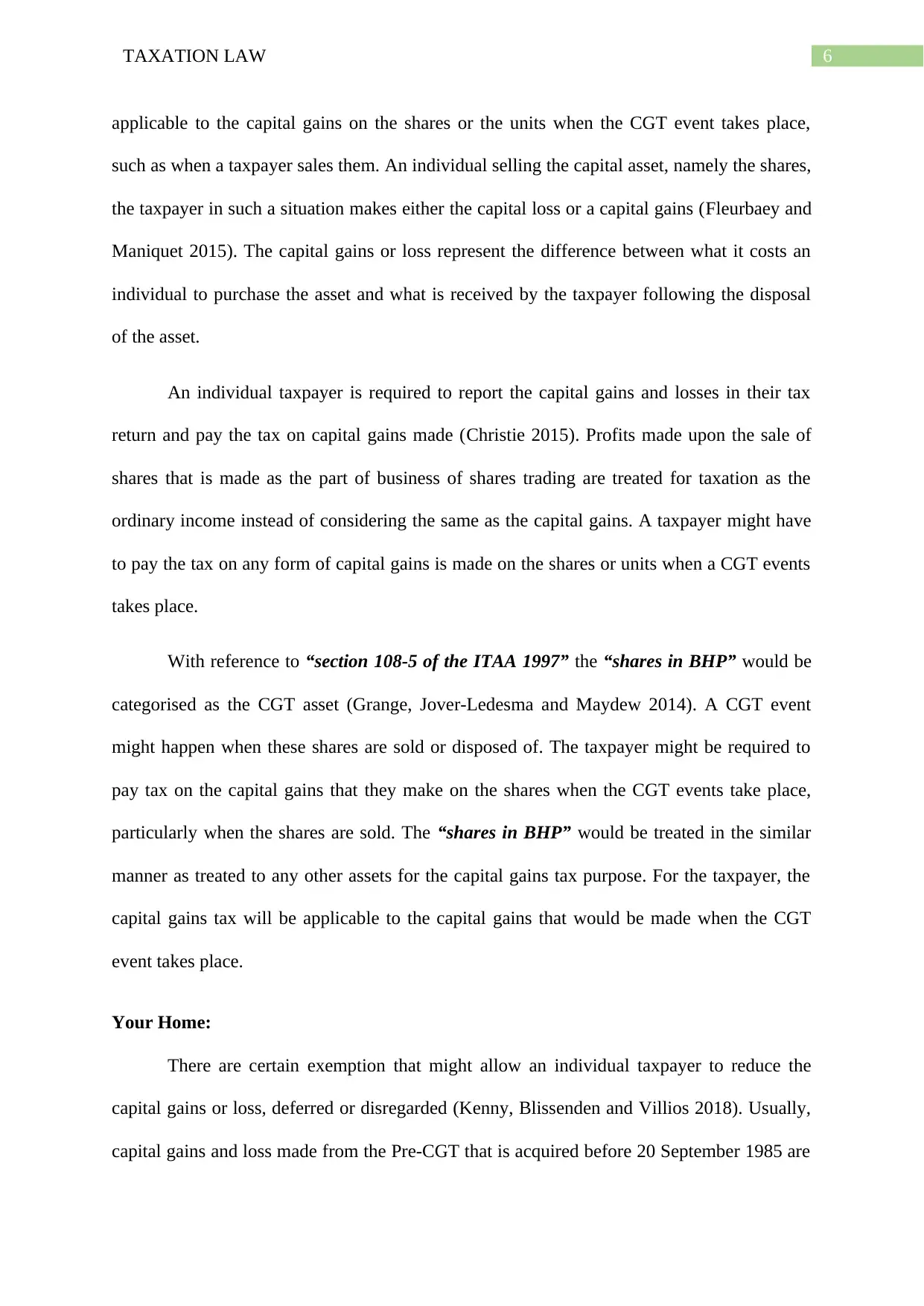
6TAXATION LAW
applicable to the capital gains on the shares or the units when the CGT event takes place,
such as when a taxpayer sales them. An individual selling the capital asset, namely the shares,
the taxpayer in such a situation makes either the capital loss or a capital gains (Fleurbaey and
Maniquet 2015). The capital gains or loss represent the difference between what it costs an
individual to purchase the asset and what is received by the taxpayer following the disposal
of the asset.
An individual taxpayer is required to report the capital gains and losses in their tax
return and pay the tax on capital gains made (Christie 2015). Profits made upon the sale of
shares that is made as the part of business of shares trading are treated for taxation as the
ordinary income instead of considering the same as the capital gains. A taxpayer might have
to pay the tax on any form of capital gains is made on the shares or units when a CGT events
takes place.
With reference to “section 108-5 of the ITAA 1997” the “shares in BHP” would be
categorised as the CGT asset (Grange, Jover-Ledesma and Maydew 2014). A CGT event
might happen when these shares are sold or disposed of. The taxpayer might be required to
pay tax on the capital gains that they make on the shares when the CGT events take place,
particularly when the shares are sold. The “shares in BHP” would be treated in the similar
manner as treated to any other assets for the capital gains tax purpose. For the taxpayer, the
capital gains tax will be applicable to the capital gains that would be made when the CGT
event takes place.
Your Home:
There are certain exemption that might allow an individual taxpayer to reduce the
capital gains or loss, deferred or disregarded (Kenny, Blissenden and Villios 2018). Usually,
capital gains and loss made from the Pre-CGT that is acquired before 20 September 1985 are
applicable to the capital gains on the shares or the units when the CGT event takes place,
such as when a taxpayer sales them. An individual selling the capital asset, namely the shares,
the taxpayer in such a situation makes either the capital loss or a capital gains (Fleurbaey and
Maniquet 2015). The capital gains or loss represent the difference between what it costs an
individual to purchase the asset and what is received by the taxpayer following the disposal
of the asset.
An individual taxpayer is required to report the capital gains and losses in their tax
return and pay the tax on capital gains made (Christie 2015). Profits made upon the sale of
shares that is made as the part of business of shares trading are treated for taxation as the
ordinary income instead of considering the same as the capital gains. A taxpayer might have
to pay the tax on any form of capital gains is made on the shares or units when a CGT events
takes place.
With reference to “section 108-5 of the ITAA 1997” the “shares in BHP” would be
categorised as the CGT asset (Grange, Jover-Ledesma and Maydew 2014). A CGT event
might happen when these shares are sold or disposed of. The taxpayer might be required to
pay tax on the capital gains that they make on the shares when the CGT events take place,
particularly when the shares are sold. The “shares in BHP” would be treated in the similar
manner as treated to any other assets for the capital gains tax purpose. For the taxpayer, the
capital gains tax will be applicable to the capital gains that would be made when the CGT
event takes place.
Your Home:
There are certain exemption that might allow an individual taxpayer to reduce the
capital gains or loss, deferred or disregarded (Kenny, Blissenden and Villios 2018). Usually,
capital gains and loss made from the Pre-CGT that is acquired before 20 September 1985 are
Paraphrase This Document
Need a fresh take? Get an instant paraphrase of this document with our AI Paraphraser
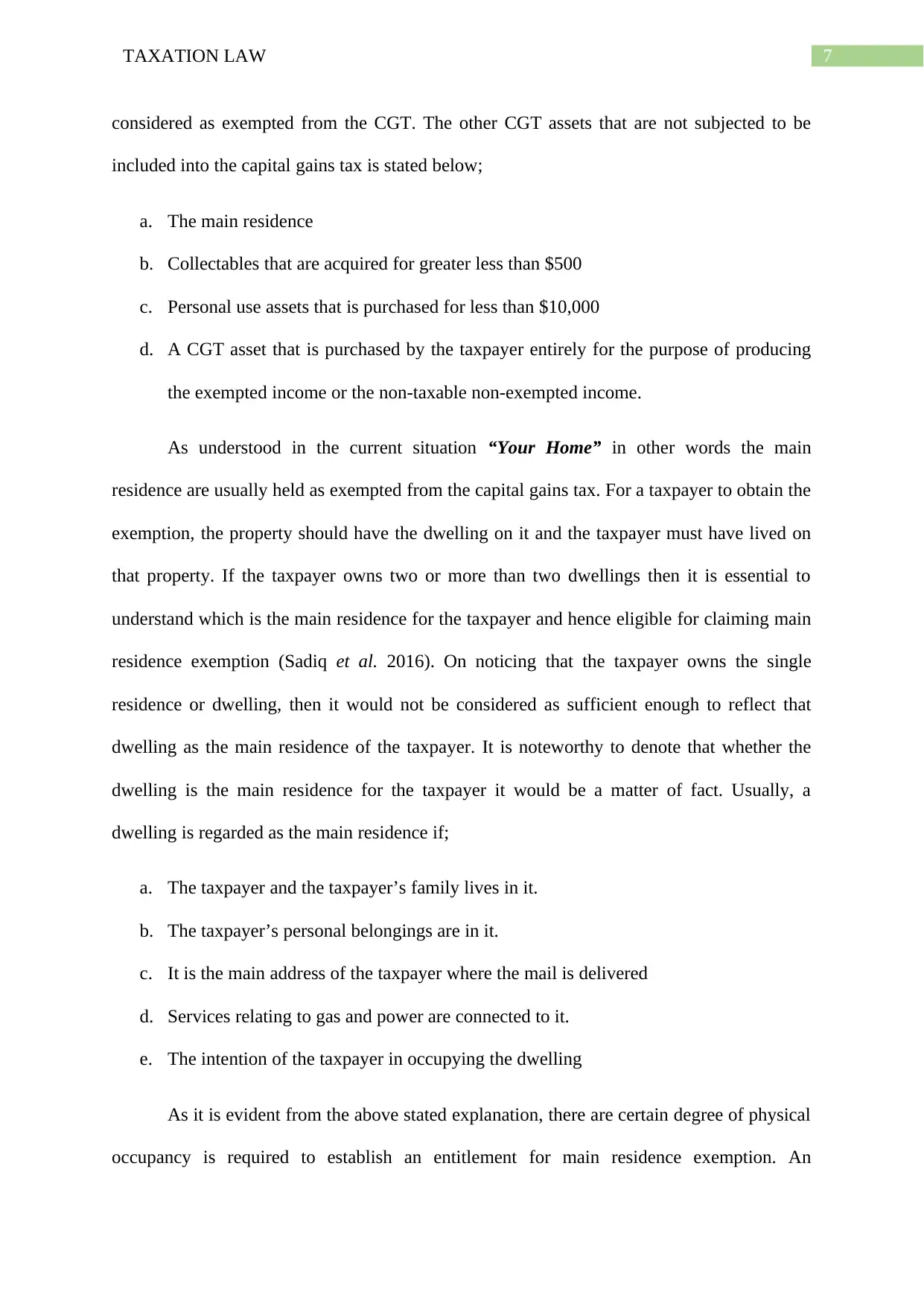
7TAXATION LAW
considered as exempted from the CGT. The other CGT assets that are not subjected to be
included into the capital gains tax is stated below;
a. The main residence
b. Collectables that are acquired for greater less than $500
c. Personal use assets that is purchased for less than $10,000
d. A CGT asset that is purchased by the taxpayer entirely for the purpose of producing
the exempted income or the non-taxable non-exempted income.
As understood in the current situation “Your Home” in other words the main
residence are usually held as exempted from the capital gains tax. For a taxpayer to obtain the
exemption, the property should have the dwelling on it and the taxpayer must have lived on
that property. If the taxpayer owns two or more than two dwellings then it is essential to
understand which is the main residence for the taxpayer and hence eligible for claiming main
residence exemption (Sadiq et al. 2016). On noticing that the taxpayer owns the single
residence or dwelling, then it would not be considered as sufficient enough to reflect that
dwelling as the main residence of the taxpayer. It is noteworthy to denote that whether the
dwelling is the main residence for the taxpayer it would be a matter of fact. Usually, a
dwelling is regarded as the main residence if;
a. The taxpayer and the taxpayer’s family lives in it.
b. The taxpayer’s personal belongings are in it.
c. It is the main address of the taxpayer where the mail is delivered
d. Services relating to gas and power are connected to it.
e. The intention of the taxpayer in occupying the dwelling
As it is evident from the above stated explanation, there are certain degree of physical
occupancy is required to establish an entitlement for main residence exemption. An
considered as exempted from the CGT. The other CGT assets that are not subjected to be
included into the capital gains tax is stated below;
a. The main residence
b. Collectables that are acquired for greater less than $500
c. Personal use assets that is purchased for less than $10,000
d. A CGT asset that is purchased by the taxpayer entirely for the purpose of producing
the exempted income or the non-taxable non-exempted income.
As understood in the current situation “Your Home” in other words the main
residence are usually held as exempted from the capital gains tax. For a taxpayer to obtain the
exemption, the property should have the dwelling on it and the taxpayer must have lived on
that property. If the taxpayer owns two or more than two dwellings then it is essential to
understand which is the main residence for the taxpayer and hence eligible for claiming main
residence exemption (Sadiq et al. 2016). On noticing that the taxpayer owns the single
residence or dwelling, then it would not be considered as sufficient enough to reflect that
dwelling as the main residence of the taxpayer. It is noteworthy to denote that whether the
dwelling is the main residence for the taxpayer it would be a matter of fact. Usually, a
dwelling is regarded as the main residence if;
a. The taxpayer and the taxpayer’s family lives in it.
b. The taxpayer’s personal belongings are in it.
c. It is the main address of the taxpayer where the mail is delivered
d. Services relating to gas and power are connected to it.
e. The intention of the taxpayer in occupying the dwelling
As it is evident from the above stated explanation, there are certain degree of physical
occupancy is required to establish an entitlement for main residence exemption. An
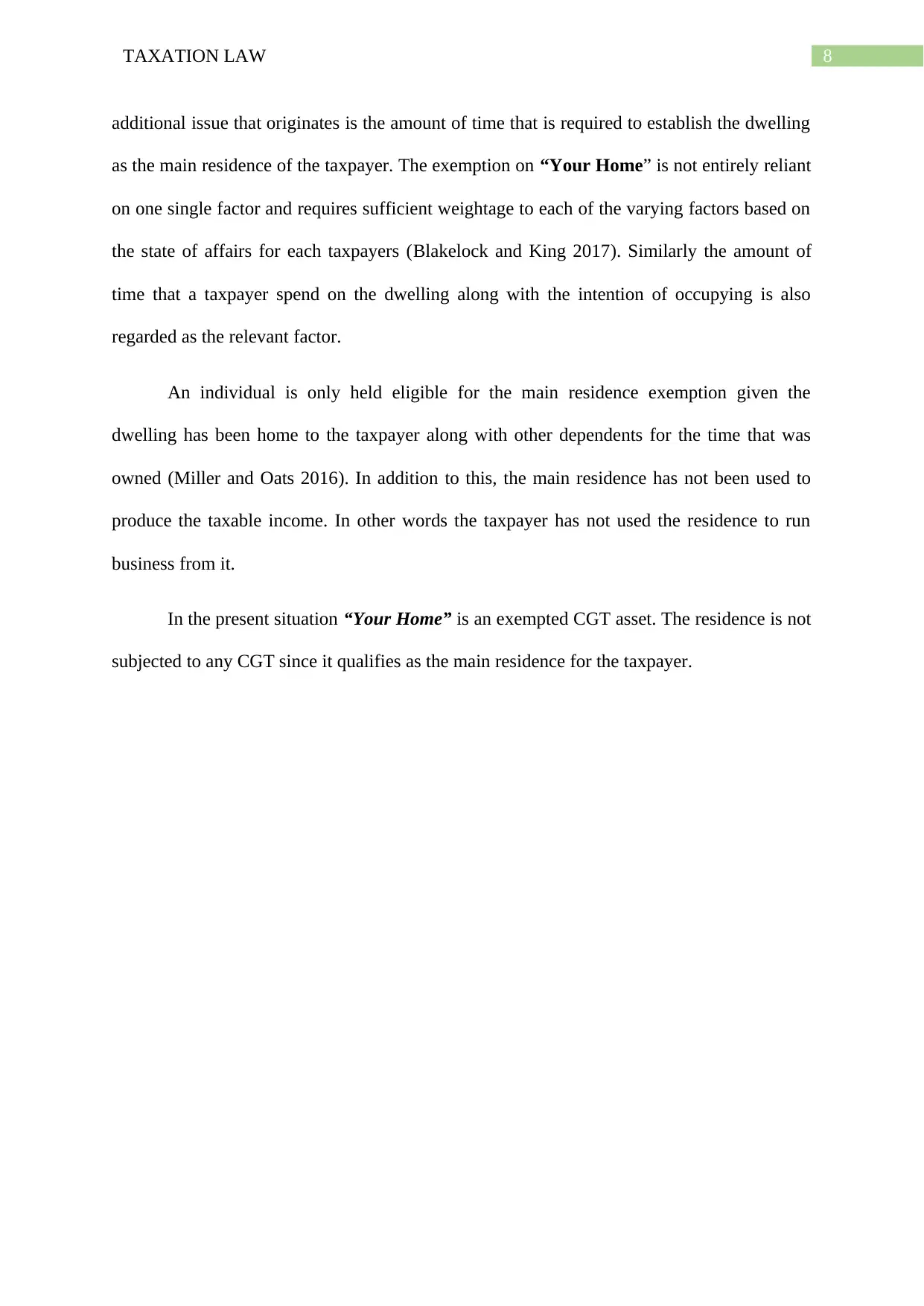
8TAXATION LAW
additional issue that originates is the amount of time that is required to establish the dwelling
as the main residence of the taxpayer. The exemption on “Your Home” is not entirely reliant
on one single factor and requires sufficient weightage to each of the varying factors based on
the state of affairs for each taxpayers (Blakelock and King 2017). Similarly the amount of
time that a taxpayer spend on the dwelling along with the intention of occupying is also
regarded as the relevant factor.
An individual is only held eligible for the main residence exemption given the
dwelling has been home to the taxpayer along with other dependents for the time that was
owned (Miller and Oats 2016). In addition to this, the main residence has not been used to
produce the taxable income. In other words the taxpayer has not used the residence to run
business from it.
In the present situation “Your Home” is an exempted CGT asset. The residence is not
subjected to any CGT since it qualifies as the main residence for the taxpayer.
additional issue that originates is the amount of time that is required to establish the dwelling
as the main residence of the taxpayer. The exemption on “Your Home” is not entirely reliant
on one single factor and requires sufficient weightage to each of the varying factors based on
the state of affairs for each taxpayers (Blakelock and King 2017). Similarly the amount of
time that a taxpayer spend on the dwelling along with the intention of occupying is also
regarded as the relevant factor.
An individual is only held eligible for the main residence exemption given the
dwelling has been home to the taxpayer along with other dependents for the time that was
owned (Miller and Oats 2016). In addition to this, the main residence has not been used to
produce the taxable income. In other words the taxpayer has not used the residence to run
business from it.
In the present situation “Your Home” is an exempted CGT asset. The residence is not
subjected to any CGT since it qualifies as the main residence for the taxpayer.
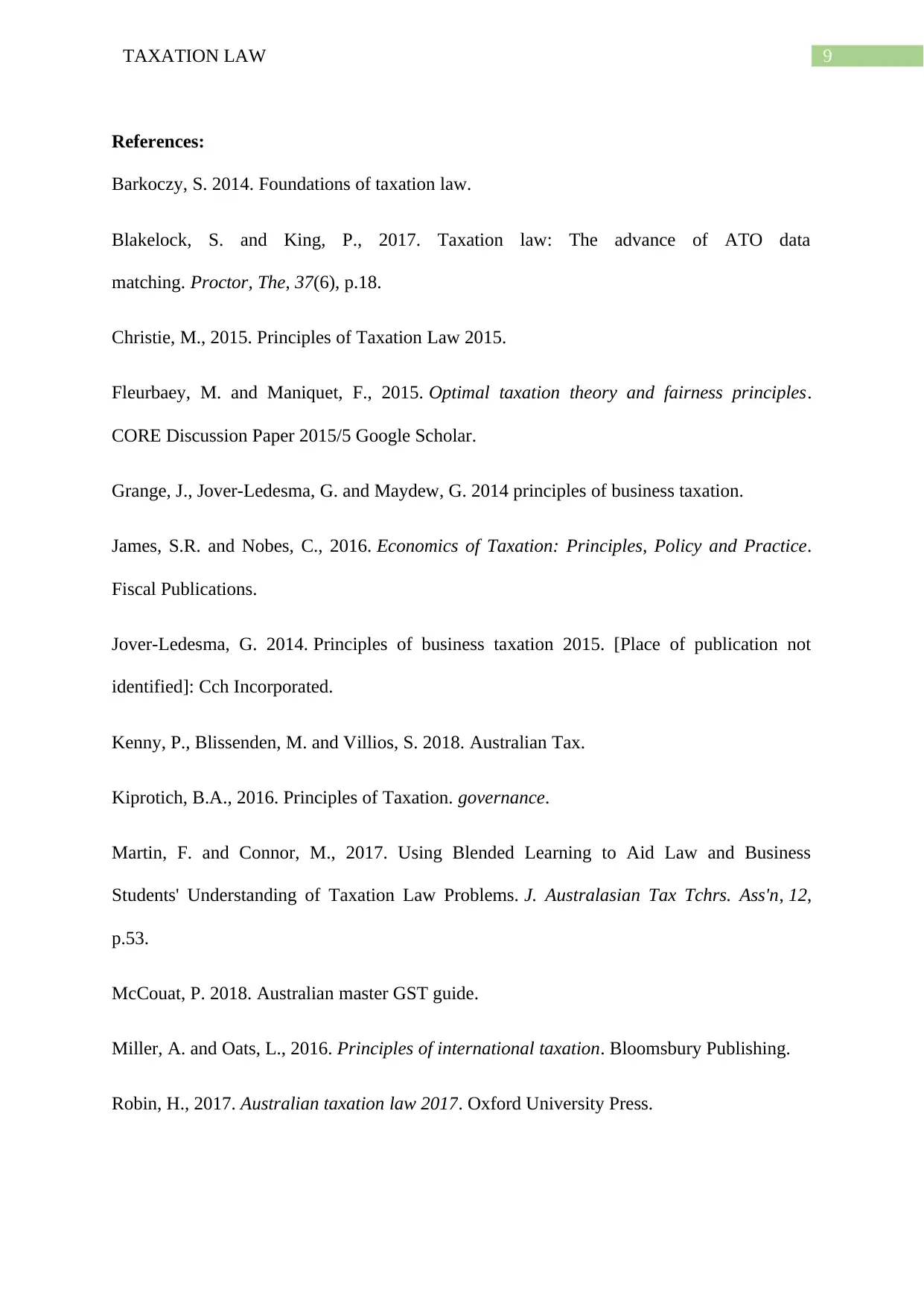
9TAXATION LAW
References:
Barkoczy, S. 2014. Foundations of taxation law.
Blakelock, S. and King, P., 2017. Taxation law: The advance of ATO data
matching. Proctor, The, 37(6), p.18.
Christie, M., 2015. Principles of Taxation Law 2015.
Fleurbaey, M. and Maniquet, F., 2015. Optimal taxation theory and fairness principles.
CORE Discussion Paper 2015/5 Google Scholar.
Grange, J., Jover-Ledesma, G. and Maydew, G. 2014 principles of business taxation.
James, S.R. and Nobes, C., 2016. Economics of Taxation: Principles, Policy and Practice.
Fiscal Publications.
Jover-Ledesma, G. 2014. Principles of business taxation 2015. [Place of publication not
identified]: Cch Incorporated.
Kenny, P., Blissenden, M. and Villios, S. 2018. Australian Tax.
Kiprotich, B.A., 2016. Principles of Taxation. governance.
Martin, F. and Connor, M., 2017. Using Blended Learning to Aid Law and Business
Students' Understanding of Taxation Law Problems. J. Australasian Tax Tchrs. Ass'n, 12,
p.53.
McCouat, P. 2018. Australian master GST guide.
Miller, A. and Oats, L., 2016. Principles of international taxation. Bloomsbury Publishing.
Robin, H., 2017. Australian taxation law 2017. Oxford University Press.
References:
Barkoczy, S. 2014. Foundations of taxation law.
Blakelock, S. and King, P., 2017. Taxation law: The advance of ATO data
matching. Proctor, The, 37(6), p.18.
Christie, M., 2015. Principles of Taxation Law 2015.
Fleurbaey, M. and Maniquet, F., 2015. Optimal taxation theory and fairness principles.
CORE Discussion Paper 2015/5 Google Scholar.
Grange, J., Jover-Ledesma, G. and Maydew, G. 2014 principles of business taxation.
James, S.R. and Nobes, C., 2016. Economics of Taxation: Principles, Policy and Practice.
Fiscal Publications.
Jover-Ledesma, G. 2014. Principles of business taxation 2015. [Place of publication not
identified]: Cch Incorporated.
Kenny, P., Blissenden, M. and Villios, S. 2018. Australian Tax.
Kiprotich, B.A., 2016. Principles of Taxation. governance.
Martin, F. and Connor, M., 2017. Using Blended Learning to Aid Law and Business
Students' Understanding of Taxation Law Problems. J. Australasian Tax Tchrs. Ass'n, 12,
p.53.
McCouat, P. 2018. Australian master GST guide.
Miller, A. and Oats, L., 2016. Principles of international taxation. Bloomsbury Publishing.
Robin, H., 2017. Australian taxation law 2017. Oxford University Press.
Secure Best Marks with AI Grader
Need help grading? Try our AI Grader for instant feedback on your assignments.

10TAXATION LAW
Sadiq, K., Coleman, C., Hanegbi, R., Jogarajan, S., Krever, R., Obst, W., Teoh, J. and Ting,
A. 2018. Principles of taxation law.
Taylor, C., Walpole, M., Burton, M., Ciro, T. and Murray, I. 2018. Understanding taxation
law.
Woellner, R., Barkoczy, S., Murphy, S., Evans, C. and Pinto, D. 2018. Australian taxation
law.
Sadiq, K., Coleman, C., Hanegbi, R., Jogarajan, S., Krever, R., Obst, W., Teoh, J. and Ting,
A. 2018. Principles of taxation law.
Taylor, C., Walpole, M., Burton, M., Ciro, T. and Murray, I. 2018. Understanding taxation
law.
Woellner, R., Barkoczy, S., Murphy, S., Evans, C. and Pinto, D. 2018. Australian taxation
law.
1 out of 11
Related Documents
Your All-in-One AI-Powered Toolkit for Academic Success.
+13062052269
info@desklib.com
Available 24*7 on WhatsApp / Email
![[object Object]](/_next/static/media/star-bottom.7253800d.svg)
Unlock your academic potential
© 2024 | Zucol Services PVT LTD | All rights reserved.





